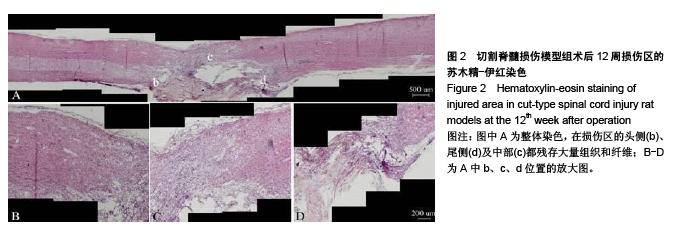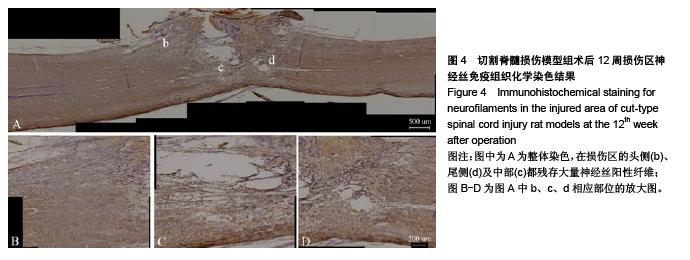中国组织工程研究 ›› 2015, Vol. 19 ›› Issue (49): 7920-7925.doi: 10.3969/j.issn.2095-4344.2015.49.009
• 脑及脊髓损伤动物模型 Animal models of brain and spinal cord injuries • 上一篇 下一篇
不同脊髓损伤模型大鼠行为学及形态学的变化
宋 伟1,2,段红梅3,饶家声3,赵 璨3,杨朝阳4
- 1首都医科大学康复医学院,北京市 100068;2中国康复研究中心康复工程研究所,北京市 100068;3北京航空航天大学生物与医学工程学院,北京市 100191;4首都医科大学北京神经科学研究所,北京市 100054
Behavioral and morphological changes of different spinal cord injury rat models
Song Wei1, 2, Duan Hong-mei3, Rao Jia-sheng3, Zhao Can3, Yang Zhao-yang4
- 1Capital Medical University of Rehabilitation Medicine, Beijing 100068, China; 2Rehabilitation Engineering Research Institute of China Rehabilitation Research Center, Beijing 100068, China; 3Biological and Medical Engineering College of Beihang University, Beijing 100191, China; 4Beijing Institute of Neuroscience, Capital Medical University, Beijing 100054, China
摘要:
背景:在脊髓全断模型中有切割伤模型、切除伤模型,为了更好地选择脊髓损伤修复研究的全断动物模型,有必要对这两种模型进行比较及探讨。 目的:分析不同脊髓损伤模型的行为学及病理变化,选择适用于再生研究及治疗的脊髓损伤动物模型。 方法:将160只SD大鼠随机均分为2组,分别制作切割型脊髓损伤模型与切除型脊髓损伤模型,术后1,2,4,8,10,20,30,50周内进行后肢行为学BBB评分及组织化学、免疫组织化学染色,观察损伤区残余纤维情况;术后4,10,26,52周分别在大鼠脑皮质运动区与颈髓注射BDA-FITC示踪剂,观察损伤区残余纤维的连续性。 结果与结论:切割脊髓损伤模型组大鼠术后2-50周双后肢的BBB得分明显高于切除脊髓损伤模型组(P < 0.05);切割脊髓损伤模型组在损伤区残存大量组织和神经丝、胶质纤维酸性蛋白纤维,而切除脊髓损伤模型几乎没有残存纤维;不论是切割脊髓损伤模型还是切除脊髓损伤模型,皮质脊髓束均不能通过损伤区,终止于损伤区的头端;在切割脊髓损伤模型中,脊髓固有束重新进入尾侧端的宿主脊髓组织中,而在切除脊髓损伤模型中脊髓固有束终止于损伤区的头端。表明切除脊髓损伤模型更适用于脊髓损伤后再生效果及治疗手段或药物的筛选与评价。
中图分类号:


.jpg)

.jpg)

.jpg)
